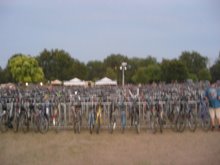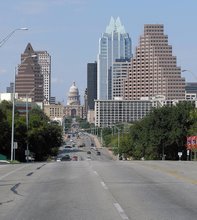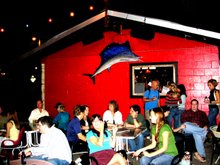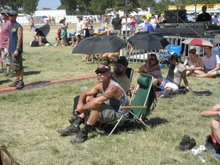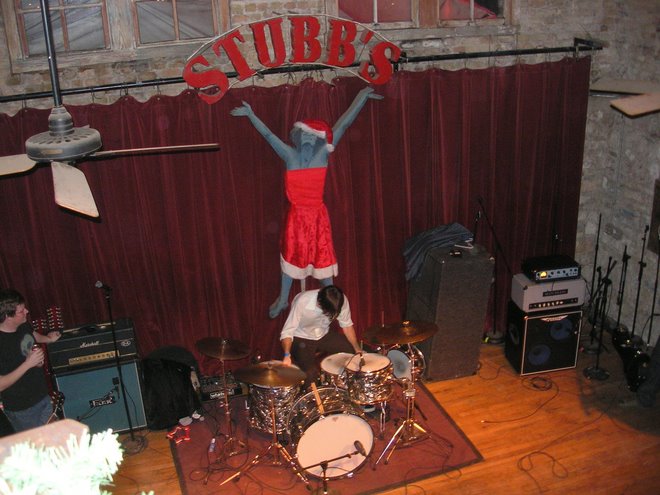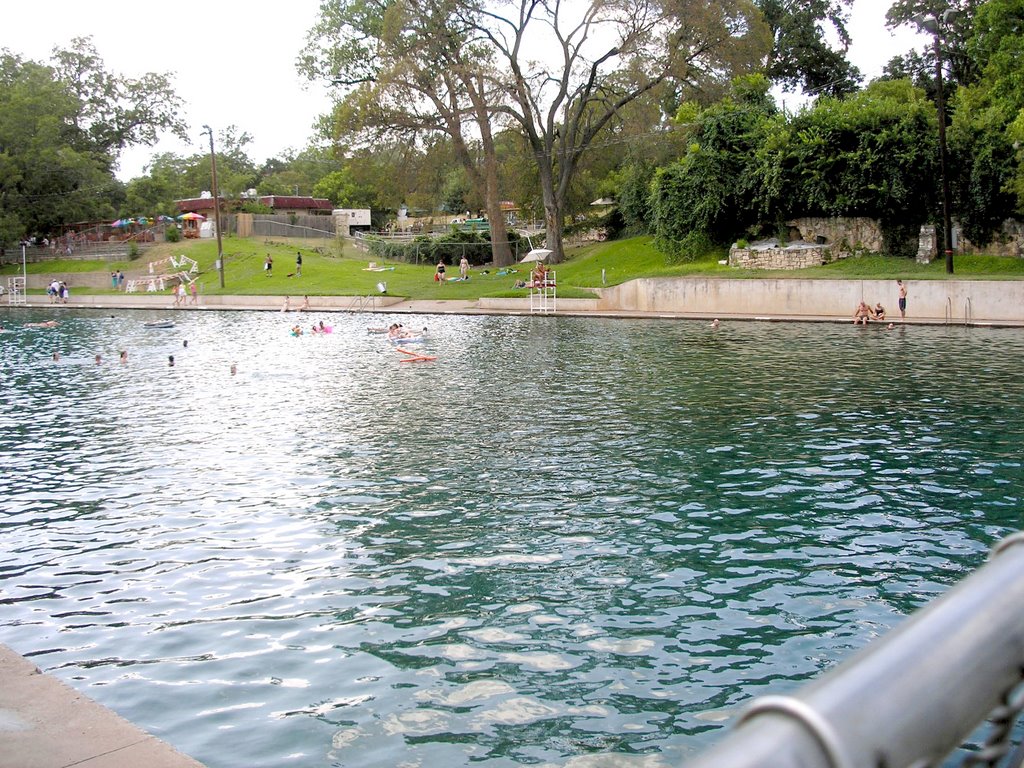Many people in America have heard of Sixth Street in Austin Texas. Some have compared it to Bourbon Street in New Orleans. Others have said it reminds them of Times Square. I think it would be correct to say that it really does not resemble either of those. The current version of Sixth Street is quite different from what it was originally. Currently Sixth Street is full of those cheap shot bars and cheap disco type places that play loud bad music. Much of the live music scene has left Sixth Street for Red River, just over a little bit or Austin's Warehouse District. The businesses on Sixth Street went after the money, not the culture. (I remember being on Sixth Street on January 5th at 1:30 in the morning right after Texas had beaten USC in the Rose Bowl. Of course I was celebrating along with thousands of others. While standing in front of one of the newer clubs on Sixth I was told to move along by the bar's bouncer because my attire didn't fit, I was in shorts and a Longhorn T-shirt. Weird, huh?)
Through most of the 1970s Sixth Street was just a place in downtown Austin, where most of the businesses had moved away and after dark there was not much going on down there. Indeed it had become kind of a bohemian area with many artists hanging out and even painting in the street. At that time cheap places to live or stay were plentiful. One could have a nice apartment or loft on Sixth Street then for about $200. There were a few places to hear live music, but these were mostly the true 'blues' music places that had been there for some time. Steamboat, one of the better known live houses in Austin, opened up in 1979 along Sixth Street as the first modern live house in that area. Stevie Ray Vaughan and others were definitely influenced by those old blues places on Sixth Street. Armadillo World Headquarters was still around until about 1981 also. Sixth Street was fun but not the big tourist spot like it is today. But in the 1970s there were some more expensive restaurants and coffee house type places but typically it was quieter at night. Now 6th Street is open until the wee hours of the morning.
I think that Sixth Street really started to ramp up the live music scene with the 1980s. Stevie Ray Vaughan and his brother's band, The Fabulous Thunderbirds, played down there often. There were any number of live houses on Sixth Street where one could get in very cheap, hang out and hear some awesome music. One place called the Black Cat Lounge, it burned down in the 90s, was one of those places that so many of the later famous Indie type bands played while they were trying to make it. Another place on Sixth Street that featured original blues, Joe's Generic Bar - burned down in 2005, was really cool and free of cover charge. Joe's was in business on Sixth Street from the 1970s. But Sixth Street was the hopping place in Austin for a long time probably up until the late 90s when those businesses decided to make a run for the easy money. Most of Sixth Street now is full of shot bars and those cheap discos with the loud worthless music. The customers in those places probably don't even know about Stevie Ray Vaughan.
Stevie Ray Vaughan first played in Austin in his teens. He and his older brother, Jimmy the blues guitar player, moved to Austin from Dallas to get into music. Stevie first played in Paul Ray's band, The Cobras, and often slept under tables at nights in the bars where he played. SRV really did suffer financially for a long time until David Bowie offered him a job in his band. He left David's band in Dallas though and returned suddenly to Austin. I actually saw him jam with his brother and the Fabulous Thunderbirds on Town Lake in the middle of Austin the very night he returned after leaving David Bowie. That was one hell of a show.
So a lot of the live music has left Sixth but it is still in Austin. Right next to Sixth is Red River, famous in the 1950s for hookers plying their trade, it is now full of places with live music. There must be 20 places to hear live music on Red River any night of the week. Other venues are around downtown Austin and one other area, the Warehouse District, is also full of live music. Recently I was talking with a much older woman about the music scene in Austin. She wasn't aware of it but remembered her good old days at the Holiday Inn in one area of Houston and the band they had there. I pictured the band from the "The Blues Brothers" before Jake and Elwood pulled them away from the empty hotel ballroom. Anyway, the music in Austin is there and waiting. I just saw the Austin band from the 90s, The ArcAngels on Friday night at Antone's.
Saturday, June 30, 2007
Thursday, June 28, 2007
Austin Music History, the next step.......
Last time I began to mention the Armadillo World Headquarters. What a place. The Armadillo was an armory building used by the Army Reserve during World War 2. The building was old and not that beautiful. It was surrounded by a dirt field which became the wonderful famous parking lot. Inside the building was the music hall which was perfect because the ceilings were high, great for sound, and it was spacious, though not glorious. Armadillo was not the kind of place people took their mothers.
Anyway, the owner and his friends fixed it up. They took some old chairs and tables and placed them outside and called it a beer garden. In the music hall, of course, beer and cheap wine was readily available. However the most popular instrument for relaxation at Armadillo was the marijuana joint. Good marijuana was plentiful and everywhere at all concerts there. There was also a grill which served the world's greasiest and healthiest nachos. About 1500 to 2000 people could fit in easily. That dirt field which became the parking lot was awesome. There were any number of large holes and pits in the parking lot and of course there are any number of stories about that parking lot. It was fun because fans and the musicians all parked there. The parking lot was one of the best places to meet famous musicians and hang out together. Many of us ended up in the parking lot for much longer than expected - typically that's where the fun began!
But how about the music? The music was outstanding. Most of the famous musicians in the world played there during the 1970s. At that time there was also a revolution in country music. Austin was the home for the "Cosmic Cowboys". They played country music with a little more rock n' roll sound at times, quite often real country too, but they dressed differently than the more traditional country artists in Nashville. Those cosmic cowboys had long hair, facial hair, and wore jeans and comfortable clothing instead of the more formal outfits those country musicians wore in Nashville. There was a cosmic country radio station in Austin called "KOKE-FM". That station's logo featured a cowboy in a cowboy hat with a big fat joint in his hand and a big smile. At that time the young people were very much into cosmic cowboy music. The local rock n' roll radio stations in Austin played that music along with their rock n' roll music.
Willie Nelson and his friends had a lot to do with the cosmic cowboy revolution. Of course they all played at the Armadillo and even hung around there often. Willie and his friends rarely, if ever, put on airs and the atmosphere at the Armadillo was incredibly laid back. Concerts were interesting. One might see a concert featuring Willie Nelson followed by Ted Nugent, or the other way around. Everyone was there for a good time. All everyone wanted was good music, the genre really didn't matter. The local Austin musicians also chipped in and performed professionally. Some were so good it was hard to imagine they were only a local band at times. The scene at Armadillo World Headquarters was unique and very interesting.
I give a lot of credit to Eddie Wilson and those who started Armadillo World Headquarters. It had a lot to do with Austin becoming one of the big centers for live music in America. Austin had live music before the Armadillo but this was the first time it was centered in one place. Next we'll talk about sixth street and Stevie Ray Vaughan.
Anyway, the owner and his friends fixed it up. They took some old chairs and tables and placed them outside and called it a beer garden. In the music hall, of course, beer and cheap wine was readily available. However the most popular instrument for relaxation at Armadillo was the marijuana joint. Good marijuana was plentiful and everywhere at all concerts there. There was also a grill which served the world's greasiest and healthiest nachos. About 1500 to 2000 people could fit in easily. That dirt field which became the parking lot was awesome. There were any number of large holes and pits in the parking lot and of course there are any number of stories about that parking lot. It was fun because fans and the musicians all parked there. The parking lot was one of the best places to meet famous musicians and hang out together. Many of us ended up in the parking lot for much longer than expected - typically that's where the fun began!
But how about the music? The music was outstanding. Most of the famous musicians in the world played there during the 1970s. At that time there was also a revolution in country music. Austin was the home for the "Cosmic Cowboys". They played country music with a little more rock n' roll sound at times, quite often real country too, but they dressed differently than the more traditional country artists in Nashville. Those cosmic cowboys had long hair, facial hair, and wore jeans and comfortable clothing instead of the more formal outfits those country musicians wore in Nashville. There was a cosmic country radio station in Austin called "KOKE-FM". That station's logo featured a cowboy in a cowboy hat with a big fat joint in his hand and a big smile. At that time the young people were very much into cosmic cowboy music. The local rock n' roll radio stations in Austin played that music along with their rock n' roll music.
Willie Nelson and his friends had a lot to do with the cosmic cowboy revolution. Of course they all played at the Armadillo and even hung around there often. Willie and his friends rarely, if ever, put on airs and the atmosphere at the Armadillo was incredibly laid back. Concerts were interesting. One might see a concert featuring Willie Nelson followed by Ted Nugent, or the other way around. Everyone was there for a good time. All everyone wanted was good music, the genre really didn't matter. The local Austin musicians also chipped in and performed professionally. Some were so good it was hard to imagine they were only a local band at times. The scene at Armadillo World Headquarters was unique and very interesting.
I give a lot of credit to Eddie Wilson and those who started Armadillo World Headquarters. It had a lot to do with Austin becoming one of the big centers for live music in America. Austin had live music before the Armadillo but this was the first time it was centered in one place. Next we'll talk about sixth street and Stevie Ray Vaughan.
Monday, June 25, 2007
日本語で天気の話 Austin Weather
This post is about Austin weather information in Japanese. For the rest of you it is simple. Austin has 2 seasons, Fall and Summer. Winter is not really much here usually, this last one was(That was very special.), and Spring and Fall are typically short. Summer is long, about 6 months with hot weather every day. By the way Austin does experience everything, including tornadoes, hail, and most others except snow. We only see snow about once every 10 years or so. Anyway, here is the Japanese for those people reading over there.
But 2007 has been strange. First of all,we had freezing temperatures in February that went on for about 3 weeks. Then Spring came and it was actually kind of long. Typically Spring and Winter really don't exist here in Austin. We have the 6 month long summer followed by a Fall type Winter. But this year Spring really did stay here for about 2 months, then we had a rainy season that kept it up until yesterday and that was weird. Right now it is only about 85 degrees outside and it should be in the high 90s. We'll survive though. The warm winters are great for the live music. One can sit outside in January in a T-shirt and enjoy good music.
「オースチンには四季がない」とよく言うが、天気はめまぐるしく変化する。日照り、雷雨、ひょう、あられ、洪水、台風、トルネード。雪は、ほとんど降らない。南の風が吹く夏は、熱帯のよう。なのに、真冬には、肌を鋭く刺す北風が吹きこむこともある。ただ、冬は比較的温暖で、気温も秋より多少低くなる程度。春には、美しい花々が咲き乱れる、もっとも美しい季節である。オースティンを訪れるのに最適なのは、10月から5月までの期間。穏やかな天候が続き、冬の寒さを体感するのはほんの数日程度である。6月から10月までは、まさに真夏だ。毎日、蒸し暑い日々が延々と続く。本当に暑い。日中の最高気温が40度になることもまれではない。この灼熱の夏が僕の一番大好きな季節。秋の訪れを告げる涼しい風を身体に感じると、大好きな夏がもうすぐ終わってしまうことを寂しく感じる。
But 2007 has been strange. First of all,we had freezing temperatures in February that went on for about 3 weeks. Then Spring came and it was actually kind of long. Typically Spring and Winter really don't exist here in Austin. We have the 6 month long summer followed by a Fall type Winter. But this year Spring really did stay here for about 2 months, then we had a rainy season that kept it up until yesterday and that was weird. Right now it is only about 85 degrees outside and it should be in the high 90s. We'll survive though. The warm winters are great for the live music. One can sit outside in January in a T-shirt and enjoy good music.
「オースチンには四季がない」とよく言うが、天気はめまぐるしく変化する。日照り、雷雨、ひょう、あられ、洪水、台風、トルネード。雪は、ほとんど降らない。南の風が吹く夏は、熱帯のよう。なのに、真冬には、肌を鋭く刺す北風が吹きこむこともある。ただ、冬は比較的温暖で、気温も秋より多少低くなる程度。春には、美しい花々が咲き乱れる、もっとも美しい季節である。オースティンを訪れるのに最適なのは、10月から5月までの期間。穏やかな天候が続き、冬の寒さを体感するのはほんの数日程度である。6月から10月までは、まさに真夏だ。毎日、蒸し暑い日々が延々と続く。本当に暑い。日中の最高気温が40度になることもまれではない。この灼熱の夏が僕の一番大好きな季節。秋の訪れを告げる涼しい風を身体に感じると、大好きな夏がもうすぐ終わってしまうことを寂しく感じる。
Sunday, June 24, 2007
Where did it all come from?
So Austin has all of this music now. Where did it come from? How did it happen this way? Hmmmmmmm, well let's see.
Of course I think the music in Austin started way back in the 1800s with the cowboys on the range riding all day long moving those cattle. After a hard day's work in the saddle, they took it easy with a large meal at the end of the day. After the meal all of the cowboys sat around taking it easy and some of them sang or played something like a guitar or harmonica along with the singing. This is most probably where the country music came from.
The other music came from the blues which came from those suffering black people who worked hard as slaves and some even harder after the Civil War. But in much the same way as those cowboys the black people enjoyed the evening times when they could just relax, sing, and make their music. That was where the blues came from.
Austin became a town in the mid-1800s when Stephen F. Austin put roots down here. At first Austin was not the capital city but shortly after Texas joined the union Austin became the capital city. Sam Houston and all of them hung around Austin. To this day there is a beer garden next to the University of Texas called "Scholtz Beer Garden" and this was one the places where Sam and his buddies liked to drink. We could have sat down with them if we had been there 150 years ago and enjoyed the liquor or beer. Austin still has good beer too from those days. We have Shiner Bock beer here in Austin and there are still any number of fine little breweries that try to keep the faith.
But the music was here in those days and people just kept on playing and enjoying themselves. Austin was probably like many other locations in the United States that supported some sort of a music scene. Typically the local musicians played for dances or celebrations. Most of these earlier musicians had real jobs to survive and only played music for fun in their free time.
I suppose the first national attention for Austin came with Janis Joplin while she was a student at the University of Texas here. She was voted "ugliest man on campus" while enjoying her studies at the University of Texas. At nights she played at an Austin bar/restaurant/beer garden called Threadgill's named after Kenneth Threadgill. He started the place back in the 1930s and kept it going after the war. Janis later left Texas and went on to national fame and more fun in San Francisco. At that time San Fran was the place to be for the hippies. They congregated there in the 60s through the late 60s. From the early 70s though they began to move. One of the places they moved to was Austin Texas.
In the early 70s the current owner of Threadgill's, Eddie Wilson, started a wonderful place to hear live music in Austin called "Armadillo World Headquarters". One of the logoes featured an armadillo at the wheel of a car racing down the highway with a human being crawling across the road. His wife was screaming "Don't hit him.", while the husband had a cruel grin plastered across his face. The Armadillo, as we call it, was truly the big start that put Austin on the national scene and garnered all the attention.
Of course I think the music in Austin started way back in the 1800s with the cowboys on the range riding all day long moving those cattle. After a hard day's work in the saddle, they took it easy with a large meal at the end of the day. After the meal all of the cowboys sat around taking it easy and some of them sang or played something like a guitar or harmonica along with the singing. This is most probably where the country music came from.
The other music came from the blues which came from those suffering black people who worked hard as slaves and some even harder after the Civil War. But in much the same way as those cowboys the black people enjoyed the evening times when they could just relax, sing, and make their music. That was where the blues came from.
Austin became a town in the mid-1800s when Stephen F. Austin put roots down here. At first Austin was not the capital city but shortly after Texas joined the union Austin became the capital city. Sam Houston and all of them hung around Austin. To this day there is a beer garden next to the University of Texas called "Scholtz Beer Garden" and this was one the places where Sam and his buddies liked to drink. We could have sat down with them if we had been there 150 years ago and enjoyed the liquor or beer. Austin still has good beer too from those days. We have Shiner Bock beer here in Austin and there are still any number of fine little breweries that try to keep the faith.
But the music was here in those days and people just kept on playing and enjoying themselves. Austin was probably like many other locations in the United States that supported some sort of a music scene. Typically the local musicians played for dances or celebrations. Most of these earlier musicians had real jobs to survive and only played music for fun in their free time.
I suppose the first national attention for Austin came with Janis Joplin while she was a student at the University of Texas here. She was voted "ugliest man on campus" while enjoying her studies at the University of Texas. At nights she played at an Austin bar/restaurant/beer garden called Threadgill's named after Kenneth Threadgill. He started the place back in the 1930s and kept it going after the war. Janis later left Texas and went on to national fame and more fun in San Francisco. At that time San Fran was the place to be for the hippies. They congregated there in the 60s through the late 60s. From the early 70s though they began to move. One of the places they moved to was Austin Texas.
In the early 70s the current owner of Threadgill's, Eddie Wilson, started a wonderful place to hear live music in Austin called "Armadillo World Headquarters". One of the logoes featured an armadillo at the wheel of a car racing down the highway with a human being crawling across the road. His wife was screaming "Don't hit him.", while the husband had a cruel grin plastered across his face. The Armadillo, as we call it, was truly the big start that put Austin on the national scene and garnered all the attention.
Subscribe to:
Comments (Atom)






















